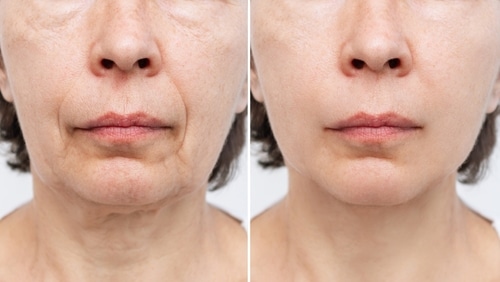New York Center for Facial Plastic Surgery
Schedule a consultation
Schedule today


A facelift, or rhytidectomy, restores the youthful appearance of the face. It reduces the sagging and folds in the skin around the cheeks and jawline, and can do other things to change the shape of your face.
It is called a facelift because a flap of skin on each side of the face is pulled back, lifting the face. But this is not merely stretching the skin back–there is also reshaping of the tissues that are underlying the skin to contour the face into a more youthful look. During this procedure, excess skin is removed as well as fat deposits that are not rearranged.
A facelift is not designed to remove fine lines and wrinkles–there are other procedures for that–but they will reshape the face to take decades off your look.
There are several different kinds of facelifts. You’ll be working with a board-certified facial plastic surgeon to ensure that you get the results you want. Make sure to ask your plastic surgeon questions including “how do they do facelifts?” You’ll peruse pictures, identify things you like and things you don’t, and your doctor should come up with a plan for the facelift surgery.
There are several different types of facelifts, and they all begin with anesthesia. Some facelifts only require sedation and local anesthesia to numb certain portions of the face and neck. But others involve the use of general anesthesia, leaving you unconscious and pain-free during the procedure. Talk to your plastic surgeon about any concerns you may have about this step, and explain what your preferences are.
Facelifts elevate the skin and tighten the tissues and muscles underneath. The natural fat in the face may be sculpted, trimmed, rearranged, or taken out completely. The facial skin is then laid back over the face, excess skin is removed, and the incisions are stitched closed.
Traditional facelifts have been the most used procedure. With this procedure, the incisions are made at your temples in the hairline, going down around your ears. Another incision can be made below your chin to tighten your neck. There are pros and cons to this procedure, which you can discuss with your plastic surgeon, but it generally provides significant results.
A mini facelift is a cosmetic surgery that uses fewer incisions compared to a traditional facelift. The purpose of a mini facelift is to get rid of sagging skin and mostly target the lower parts of the face, such as the neck and jawline.
A neck lift incision begins at your ear and runs into your lower scalp, with another incision under your chin. This procedure works best for tightening the skin around your neck.
Some symptoms following a facelift, such as bruising, swelling, numbness, and some pain, are normal. Some drainage may also occur. You’ll need to wear a bandage around your face for a few days. After that, you’ll receive a small elastic sling to replace it. A week after surgery, the doctor will remove the sutures and examine the effects of the facelift.

Accessibility: If you are vision-impaired or have some other impairment covered by the Americans with Disabilities Act or a similar law, and you wish to discuss potential accommodations related to using this website, please contact our Accessibility Manager at (212) 570-2500 .